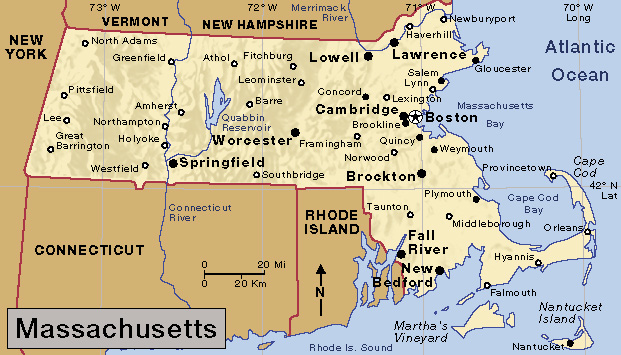New Bedford, Massachusetts (pop. 101,079), is one of the leading commercial fishing ports of the United States. It is located in southeastern Massachusetts. The city lies where the Acushnet River empties into Buzzards Bay, about 50 miles (80 kilometers) south of Boston. New Bedford is in the Providence (Rhode Island)-Warwick (Rhode Island) metropolitan area, which has 1,676,579 people.

New Bedford’s chief industry is the production of seafood. The city’s annual fish catch has a higher value than that of any other city in the United States. The city’s fishing fleet is one of the leaders in the world in catching flounders and sea scallops. Other major industries produce electric equipment, rubber goods, and textiles. The city also is a trade and distribution center of southeastern Massachusetts. It has an expanding tourist industry.
Through the years, large numbers of Portuguese immigrants have settled in New Bedford. The Feast of the Blessed Sacrament, a four-day midsummer Portuguese festival, attracts tens of thousands of visitors.
Wampanoag Indians lived in what is now the New Bedford area before white settlers arrived there. In 1652, a group of Pilgrims bought land from Massasoit, the Wampanoag chief, and founded a settlement. The settlement later was named for the Duke of Bedford.
New Bedford developed slowly until the 1760’s, when the colonists established a whaling industry. By the mid-1800’s, New Bedford had become the whaling capital of the world. The Wamsutta Mills, the city’s first major textile plant, opened in 1846. New Bedford received a city charter in 1847.
New Bedford’s whaling industry declined rapidly during the late 1800’s, chiefly because petroleum products replaced whale oil for many purposes. Exhibits of the whaling era are featured at the New Bedford Whaling Museum in downtown New Bedford. A textile boom during the 1880’s made the city a leading producer of cotton fabrics.
During the middle and late 1900’s, New Bedford began several construction projects. A dike that protects the city’s harbor from hurricanes was completed in 1966. In 1996, New Bedford Whaling National Historical Park was created to commemorate New Bedford’s whaling industry of the 1800’s. The park spreads over 13 city blocks and includes the New Bedford Whaling Museum, a whaling schooner, and several historical structures. New Bedford has a mayor-council form of government.
